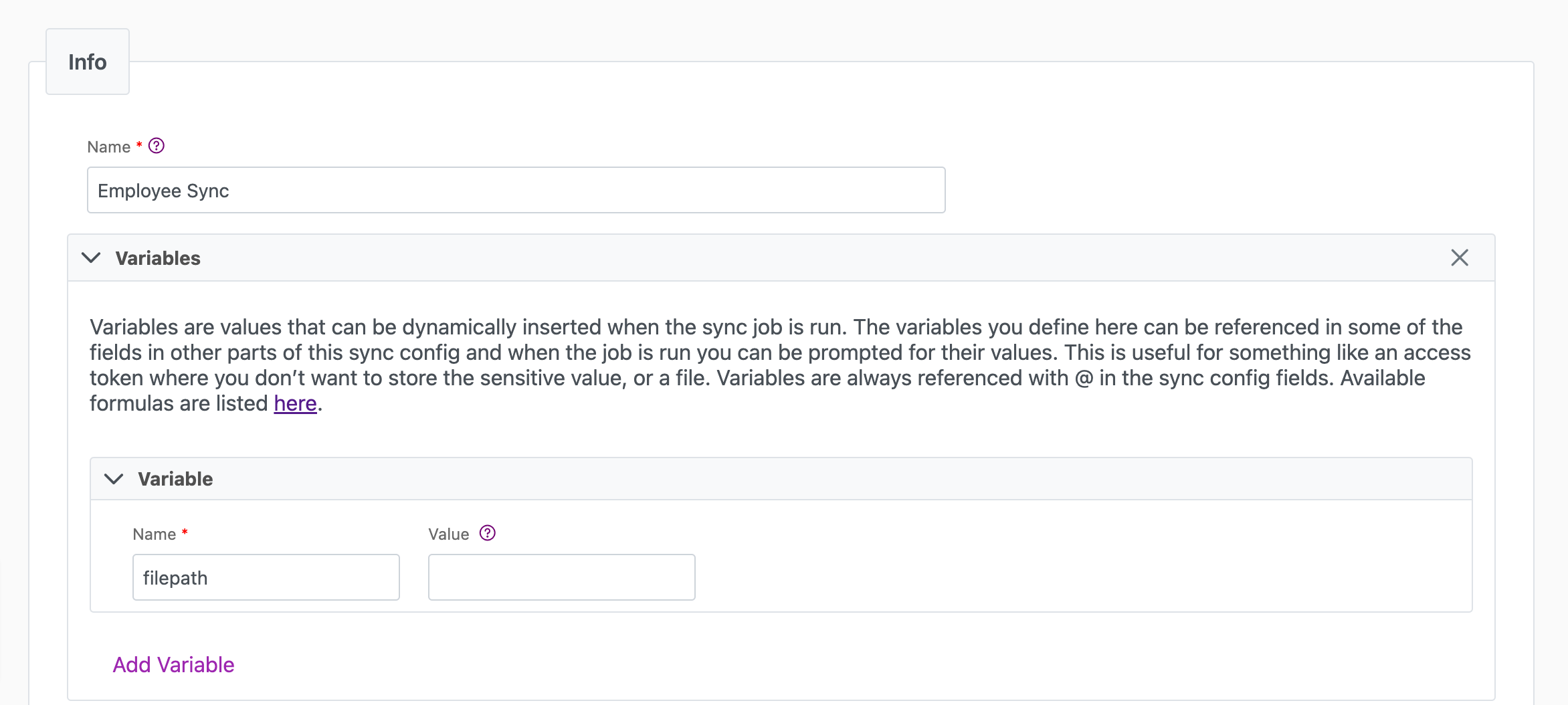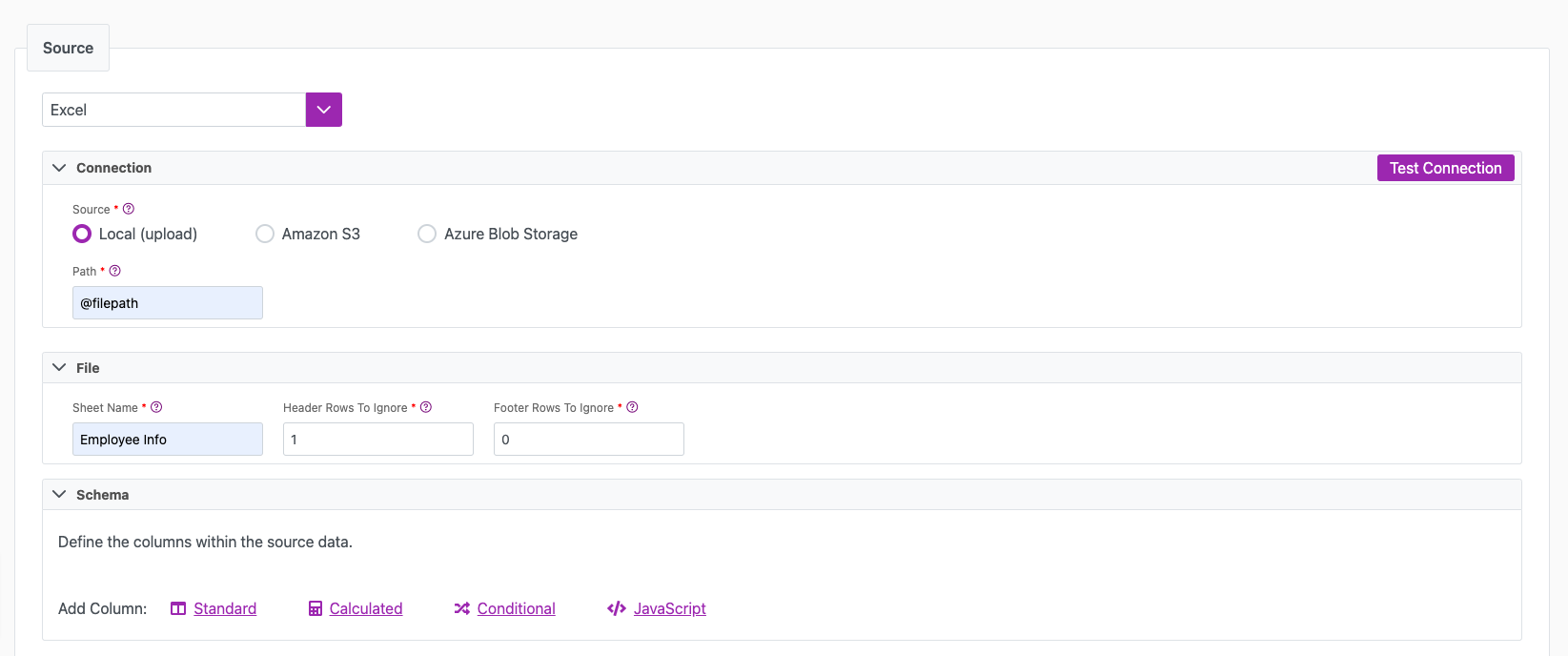Excel
Overview
Microsoft Excel is a commonly spreadsheet program for managing and analyzing numerical data. You can use Microsoft Excel as a source for your Data Syncs by following the instructions below.
Example use case
You have an Excel spreadsheet that contains your Employee information. You want to use a batch sync to pull this info into a Cinchy table and liberate your data.
The Excel source supports batch syncs.
The Excel source doesn't support Binary data types.
Info tab
You can find the parameters in the Info tab below (Image 1).
Values
| Parameter | Description | Example |
|---|---|---|
| Title | Mandatory. Input a name for your data sync | Employee Sync |
| Variables | Optional. Review our documentation on Variables herefor more information about this field. When uploading a local file, set this to @filepath. | @filepath |
| Permissions | Data syncs are role based access systems where you can give specific groups read, write, execute, and/or all of the above with admin access. Inputting at least an Admin Group is mandatory. |

Source tab
The following table outlines the mandatory and optional parameters you will find on the Source tab (Image 2).
- Source Details
- Schema
- Filter
The following parameters will help to define your data sync source and how it functions.
For information on setting up registered applications for S3 or Azure, please see the Registered Applications page.
| Parameter | Description | Example |
|---|---|---|
| (Sync) Source | Mandatory. Select your source from the drop-down menu. | Delimited File |
| Source | Location of the source file. Supports Local upload, Amazon S3, Azure Blob Storage with various authentication methods. | Local |
| Sheet Name | Mandatory. Name of the sheet to sync. | Employee Info |
| Header Rows to Ignore | Mandatory. Number of top rows to ignore before data starts (includes column header). | 1 |
| Footer Rows to Ignore | Mandatory. Number of bottom rows to ignore. | 0 |
| Path | Mandatory. Path to source file. Local file upload requires Variable in Info tab. | @Filepath |
| AuthType | Defines the authentication type. Supports "Access Key" and "IAM role". | |
| Test Connection | Use to verify credentials. If successful, a "Connection Successful" pop-up appears. |
The Schema section is where you define which source columns you want to sync in your connection. You can repeat the values for multiple columns.
| Parameter | Description | Example |
|---|---|---|
| Name | Mandatory. The name of your column as it appears in the source. | Name |
| Alias | Optional. You may choose to use an alias on your column so that it has a different name in the data sync. | |
| Data Type | Mandatory. The data type of the column values. | Text |
| Description | Optional. You may choose to add a description to your column. |
Select Show Advanced for more options for the Schema section.
| Parameter | Description | Example |
|---|---|---|
| Mandatory |
| |
| Validate Data |
| |
| Trim Whitespace | Optional if data type = text. For Text data types, you can choose whether to trim the whitespace._ | |
| Max Length | Optional if data type = text. You can input a numerical value in this field that represents the maximum length of the data that can be synced in your column. If the value is exceeded, the row will be rejected (you can find this error in the Execution Log). |
You can choose to add in a Transformation > String Replacement by inputting the following:
| Parameter | Description | Example |
|---|---|---|
| Pattern | Mandatory if using a Transformation. The pattern for your string replacement. | |
| Replacement | What you want to replace your pattern with. |
Note that you can have more than one String Replacement
You have the option to add a source filter to your data sync. Please review the documentation here for more information on source filters.

Next steps
- Configure your Destination.
- Define your Sync Actions.
- Add in your Post Sync Scripts, if required.
- Click Jobs > Start a Job to begin your sync.